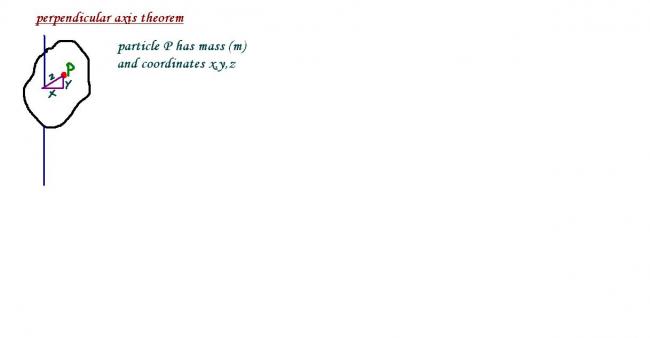 1
1perpendicular axis theorem is for laminar bodies.. and is more or less a direct result of the pythagoras theorem.
parallel axis proof is also kind of simple....feeling very lazy now.
maybe someone who doesnt know this should try first.
 19
19PERPENDICULAR AXIS THEOREM :
x2 + y2 = z2
=> mx2 + my2 = mz2
=> Σ mx2 + Σmy2 = Σmz2
=> IX + IY = IZ
THIS THEOREM IS NOT APPLICABLE FOR A BODY WHICH IS SYMMETRIC ABOUT ALL THREE AXES !
(similarly for parallel axis theorem !)

 62
62is Ix = Σ m x2 ??
Think of a rod placed along the Y axis...
x = 0 there.. then the moment of inertia of the rod about the X axis should have been zero!
 1
1hmmm I agree that the notation is a bit confusing perhaps
however;
we define the second moment of inertia of a body about an axis O
such that
I_0=\sum{m_ir^2}
where r is the _|_ distance of the ith particle from the axis O.
so particularly for laminar bodies it is clear that
I_x=\sum{m_iy^2} \\and \ I_y=\sum{m_ix^2}
where x and y are the 'x' and 'y' coordinates respectively of the ith particle in the respective equations
now the _|_ distance from the z axis of any point (x,y) on the x, y plane is √x2+y2
so I_z=\sum{m_i(x^2+y^2)}=I_y+I_x
 62
62That's COrrect philip [1]
 19
19sorry for the trouble ! [2] [2] [2]
 1
1Anyone trying parallel axis theorem.... ?
Hint : Start from the definition I gave in #5
the rest is algebra and common sense
